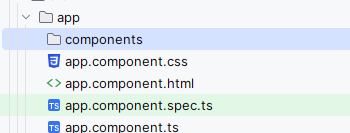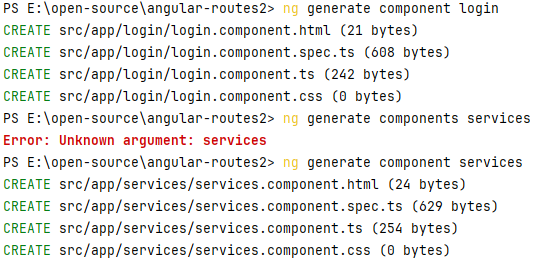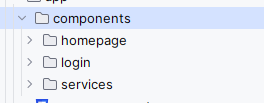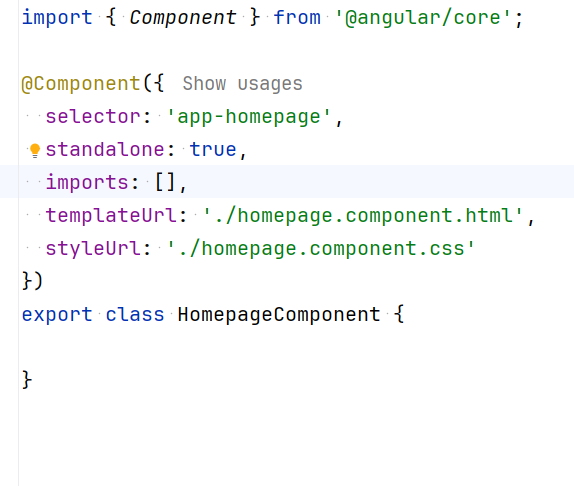Angular Create Components, Modules, and Routes
 Thirdy Gayares
Thirdy Gayares
Components
Components are building blocks in Angular applications. Each component contains the HTML, CSS, and logic for a part of the user interface. You can think of them like small, reusable parts of a webpage.
Module
A module is a container for a set of components, services, and other code that works together in an Angular application. The root module, usually named AppModule, starts the application and contains all other components.
Routes
Routes define how users navigate between different pages or views in your application. You set up routes so that when users click a link, they see the right content (such as the Homepage or Login page).
Router
The Angular router helps manage navigation between different views or pages. It allows you to change the visible part of the application based on the URL without reloading the entire page.
1. Create a folder named components
In your Angular project, create a folder named components. This folder will contain all the individual components of your project, like the homepage, login, and services.

2. Generate 4 Components
You can generate components by running the Angular CLI command in your terminal:
ng generate component components/homepage
ng generate component components/login
ng generate component components/services
ng generate component components/[another-component]
These commands will create the necessary files for each component in the components folder.


3. Move the 3 Folders to the Components Folder
If you generated the components in the wrong location, move the folders to the correct components folder.

4. Add app.module.ts
Ensure the app.module.ts file is set up to include the necessary imports for routing, form handling, animations, and the components. Follow the provided structure in your example.

Content of app.module.ts
import { NgModule } from '@angular/core';
import { BrowserModule } from '@angular/platform-browser';
import {RouterModule, Routes} from '@angular/router';
import {ReactiveFormsModule} from '@angular/forms';
import {CommonModule} from "@angular/common";
import {BrowserAnimationsModule} from "@angular/platform-browser/animations";
import {AppComponent} from "./app.component";
import {provideAnimationsAsync} from "@angular/platform-browser/animations/async";
import {HomepageComponent} from "./components/homepage/homepage.component";
import {LoginComponent} from "./components/login/login.component";
import {ServicesComponent} from "./components/services/services.component";
const routes: Routes = [
{ path: '', component: HomepageComponent },
{ path: 'login', component: LoginComponent },
{ path: 'services', component: ServicesComponent },
];
@NgModule({
imports: [
CommonModule,
BrowserModule,
BrowserAnimationsModule,
ReactiveFormsModule,
RouterModule.forRoot(routes, {enableTracing: true}),
],
exports: [RouterModule],
declarations: [
AppComponent,
],
providers: [
provideAnimationsAsync(),
],
bootstrap: [
AppComponent
]
})
export class AppModule { }
5. Remove standalone: true and imports: [] from All Components
In each component's .ts file, remove the lines standalone: true and imports: [], since they are not needed in this project setup.

6. Update main.ts
Ensure that main.ts bootstraps (starts) the application with the AppModule as shown in your example.
import { platformBrowserDynamic } from '@angular/platform-browser-dynamic';
import { AppModule } from './app/app.module';
platformBrowserDynamic().bootstrapModule(AppModule)
.catch(err => console.error(err));
7. Update app.component.html
Modify app.component.html to include the navigation links and the router-outlet, which will display the routed views.
<a routerLink="/">Homepage</a>
<br>
<a routerLink="/login">Login</a>
<br>
<a routerLink="/services">Services</a>
<router-outlet></router-outlet>
8.OUTPUT

Github link
Subscribe to my newsletter
Read articles from Thirdy Gayares directly inside your inbox. Subscribe to the newsletter, and don't miss out.
Written by

Thirdy Gayares
Thirdy Gayares
I am a dedicated and skilled Software Engineer specializing in mobile app development, backend systems, and creating secure APIs. With extensive experience in both SQL and NoSQL databases, I have a proven track record of delivering robust and scalable solutions. Key Expertise: Mobile App Development: I make high-quality apps for Android and iOS, ensuring they are easy to use and work well. Backend Development: Skilled in designing and implementing backend systems using various frameworks and languages to support web and mobile applications. Secure API Creation: Expertise in creating secure APIs, ensuring data integrity and protection across platforms. Database Management: Experienced with SQL databases such as MySQL, and NoSQL databases like Firebase, managing data effectively and efficiently. Technical Skills: Programming Languages: Java, Dart, Python, JavaScript, Kotlin, PHP Frameworks: Angular, CodeIgniter, Flutter, Flask, Django Database Systems: MySQL, Firebase Cloud Platforms: AWS, Google Cloud Console I love learning new things and taking on new challenges. I am always eager to work on projects that make a difference.